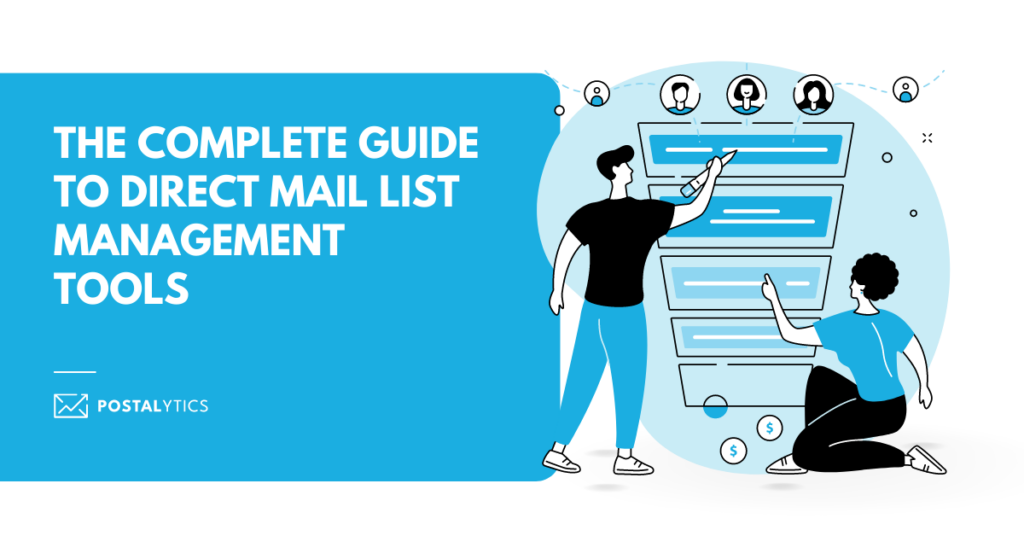
If your direct mail campaigns are delivering great results, chances are you’re managing multiple targeted lists to reach the right audience. As your business grows, efficient direct mail list management becomes essential for maintaining accuracy and maximizing impact.
With an increasing number of mailing lists, the challenge becomes clear—how do you organize and optimize your data to send the right messages to the right people, streamline operations, and boost conversion rates? The right tools make all the difference, helping you save time, reduce costs, and enhance the effectiveness of every direct mail campaign.
The simple answer is using a direct mail list management tool.
As a direct mail automation platform providing various list management tools, we created this guide to go through list management, best practices and some of the most effective tools.
What We’ll Cover:
- Understanding Direct Mail List Management
- Why is Direct Mail List Management Important?
- Best Direct Mail List Management Tools
- Native List Upload .CSV and Excel
- Native List Upload – Integrations
- Mailing List Rental Options
- List De-duplication and Slashing Costs
- List Address Field Validation
- Invalid Address Management
- List Editing Tools
- List Download
- List Append Tools
- List Field Mapping Tools
- Search/Delete Contacts (CCPA Compliance)
- How Direct Mail List Management Works
- Final Thoughts
Understanding Direct Mail List Management
Direct mail list management involves managing and controlling your contact database in lists and segments.
You can create different mailing lists depending on who they are (newsletter subscribers, leads, existing customers, trial users, lead magnet downloaders, etc.) and their engagement level.
Many businesses create lists depending on the recipient’s actions or interests. For example, if someone entered their details for an upcoming event, you can put this information into a separate mailing list and send them your event invites as a direct mail campaign.
Effective direct mail list management involves using a direct mail platform to keep your list active, healthy, organized and engaged. You’ll need specifically designed software to manage all of this, thus the need for direct mail list management tools.
Why is Direct Mail List Management Important?
If you want to improve conversions on your campaigns or develop a direct mail marketing strategy that beats the competition and generates an excellent ROI, direct mail list management isn’t an option; it’s essential.
Here are five key benefits of direct mail list management:
Accurate Address Verification
Have you ever received a direct mail piece because someone manually entered the wrong address? Your team would have to go through the process of re-printing the address in the mailer and sending it again, which results in an unnecessary waste of time and resources.
Direct mail automation software allows you to organize your data so that all the addresses are verified, and there is no chance of manual error when you import these lists directly to your campaigns.
Enhancing Campaigns with Segmentation & Personalization
Did you know that segmented marketing campaigns have been shown to generate a 760% increase in revenue?
This is because personalization helps you create targeted messaging for specific customers. So, for example, the offers you send to trial customers would differ completely from those you send to your premium customers.
Direct mail list management helps you create these segmented lists to personalize your direct mail campaigns and get better results. This also gives you a better understanding of your audience and the kind of offers and strategies that tick for them.
The Role of Integration and Analytics in Direct Mail
Most list management tools integrate with your other sales and marketing tools to easily export and import lists. This saves your team a lot of manual work and, in turn, errors and inconsistencies that happen because of them.
You can even analyze the effectiveness of your personalized campaigns by utilizing the analytics features in these direct mail automation software tools. Important campaign performance metrics like response rate, the percentage of people that acted on the CTA, etc., can be measured and optimized.
Build healthy relationships
Direct mail marketing works best when you take into account your audience’s interests, behaviors and motivations. For example, by sending your recent subscribers upcoming event details that will help them succeed with your tool, you can engage them and ensure retention.
These relevant offers and quality content help you connect better with your customers and prospects. This relationship-building is especially important if your business deals with few but enterprise-level customers.
Maintain accurate lists
It’s important that you keep your lists updated and engaged. This will also help you track current addresses and delete old ones no longer associated with your current clients. This results in better mail deliverability, fewer returns, good user engagement, and improved sender reputation.
You can also avoid sending mails to people who don’t want to receive them.
Best Direct Mail List Management Tools
Direct mail automation software allows you to store and organize your mailing lists so you don’t have to create them from scratch for different campaigns. You can even easily import them with integrations in these tools. Let’s look at 12 such powerful tools.
Native List Upload .CSV and Excel
Postalytics provides importing software that deals with all the common problems you encounter while importing data into Postalytics from spreadsheets. For example, it fixes zip codes that are missing leading zeros or throws out file format issues.
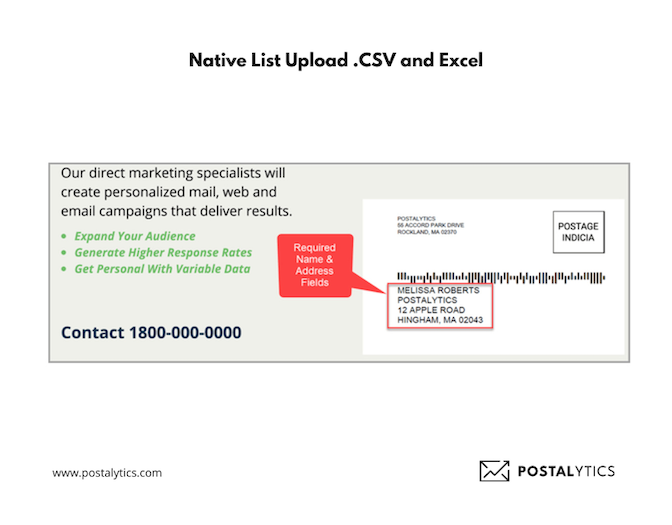
You can enable list preview data that shows you the data before your importer gets hold of it. If you see any errors or inconsistencies, you can remedy that before spending time on import.
While uploading and importing, the Postalytics mapping tool will automatically recognize and map column headers that match the standard contact record fields like first name, last name, address, company, etc. You can even add up to 35 additional user-defined personal fields while importing.
Native List Upload – Integrations
You might already have lists ready for your digital marketing campaigns. If you want to use these same lists instead of starting from scratch, Postalytics provides native list uploads via integrations to all common marketing automation tools like HubSpot, Klaviyo, Salesforce, etc.
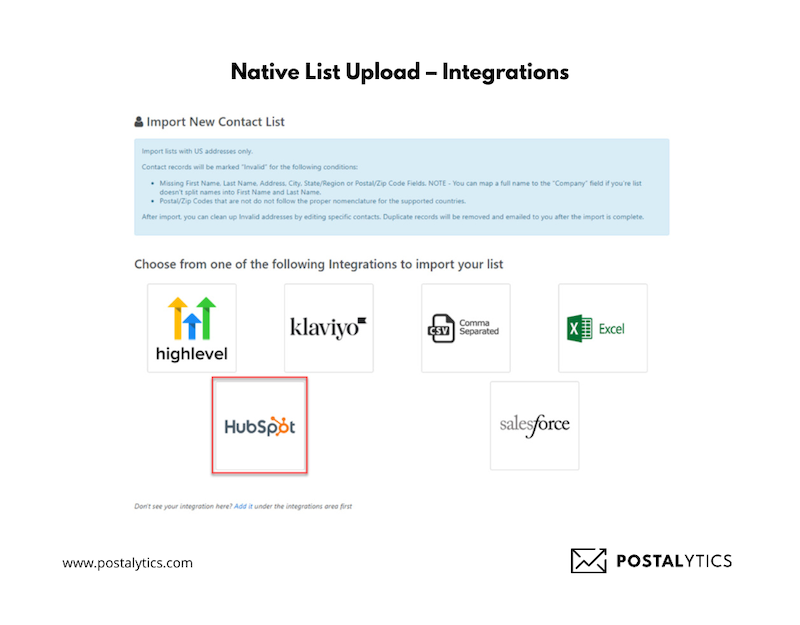
To make this import error-free, our direct mail management software checks each record to ensure it has the minimum required fields for proper mailing. If a contact does not have the required fields, the import will be done, but it will be labeled as invalid and cannot be mailed until the error is fixed.
If you have any personalization fields, these can be used via the variable data and variable logic tools present in the direct mail editor.
Mailing List Rental Options
Have you just started out? Or do you have specific lists for your location, but you want to target a different location?
In this scenario, you can rent mailing lists created by the Postalytics team using multiple authentic sources like government records, telephone directories, private data sources, etc. for certain prices.
You can target consumers, businesses, or occupants with highly targeted demographic and geographic filters like age, sex, income, home ownership, radius, zip codes, counties, states, company size, etc.

If you need access to a specific list that isn’t available for these categories, you can contact your Postalytics sales or client success rep to discuss getting the kind of list you require.
List De-duplication and Slashing Costs
Many of your lists may contain duplicate contacts. This may be because the same entry has been made twice, or you may have imported the records twice. Whatever the reason, your costs can easily shoot up if you send a direct mail piece twice to a single address.
In Postalytics, each contact in a list is examined, and if it has the exact same name and address, the contact is removed. This saves your team considerable time and energy as they don’t have to search the lists manually.

To ensure the list de-duplication has taken place in a full-proof manner, you’ll be mailed a list of invalid records after the list is uploaded so you can cross-check.
List Address Field Validation
Getting the mail bounce rate low is important for any business that uses direct mail marketing. A high rate indicates that your process is not optimized and there is incorrect data in your address database. This leads to campaigns that underperform and postage that goes to waste.
To avoid this, Postalytics provides an advanced address verification system that takes care of two things: automated checks to ensure address data is formatted correctly and built-in address ranges in templates to ensure design changes do not impact your mailer’s deliverability.
We also run all the addresses through USPS’s CASS database to ensure the addresses are valid. The NCOA (National Change Of Address) database is also consulted to get the most up-to-date address of your recipients.

Invalid Address Management
To avoid sending mail to an address with incomplete data, Postalytics checks each record in the list to ensure it has the minimal data required to send for mailing. The minimum required fields are first, last, and company names. The address part should have address detail, city, state, zip code and country.
For each record with something missing or invalid characters in the data, Postalytics will import the data but mark it as “invalid.”
A few campaign-driven reasons also lead to a contact being marked invalid. These could be a USPS return to sender scan, an invalid address check at sending time, or a USPS rerouted scan.

You can even search and edit all the invalid records to pass the automated check.
List Editing Tools
Instead of editing in different Excel files and creating different versions of the same mailing list, you can easily view, edit, download, and append your mailing lists in Postalytics.
You can add, remove, or edit contacts with invalid addresses or other data that might have errors.
To edit a list, go to the main navigation bar and click Lists. Then, select the view lists option.

Once you have created different mailing lists, you’ll see them all here. To edit a list, click the edit button on the right. To edit a particular record, click the action button and select edit.

Once it is edited, you can save the record. You can even scroll down to see each contact record’s created and updated date.
List Download
Your team might need to download these lists for a number of reasons. For example, if you’re an agency handling direct mail campaigns for your clients, you may need lists you can easily share with your clients.

One way is by inviting these clients to use the Postalytics platform. Another way is to download your mailing lists and email them to your clients.
If you want to know more about how direct mail lists are put together and used in campaigns, here’s a guide to help you.
List Append Tools
Want to add records of an old list to a new one? You can easily append lists with Postalytics. The only thing you need to take care of is that the contact records you wish to add must contain the same data fields and the same mapping as the contact list you’re adding to.
Your append file must be in a .CSV format or an Excel file. To append your list, go to the home page main navigation bar, and click Lists to go to the Contact Lists page.
Find the list you want to append and click the action button and the Append link from the dropdown.

The following screen will pop up where you can upload the file you want to append to your list.
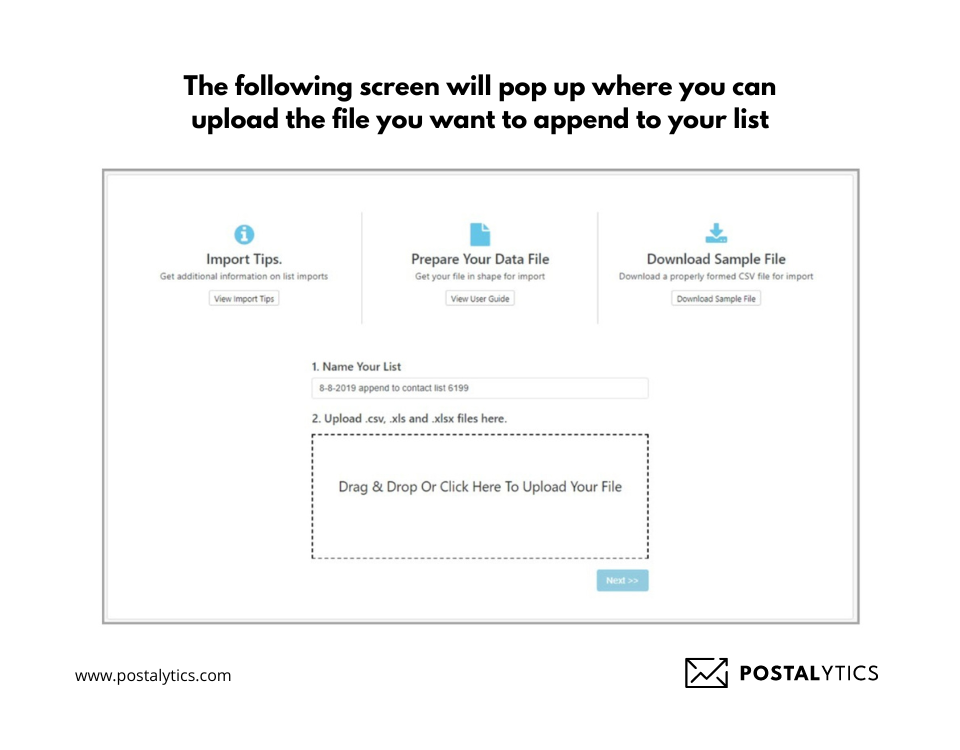
If Postalytics finds any duplicate records, only one of the duplicates will be kept in your list, and these records will be sent to you via email.
List Field Mapping Tools
You may need to add new fields to your existing lists that have already been uploaded and mapped.
To do that, go to your Lists page. Then, click on the edit button to find all the existing fields in the list.
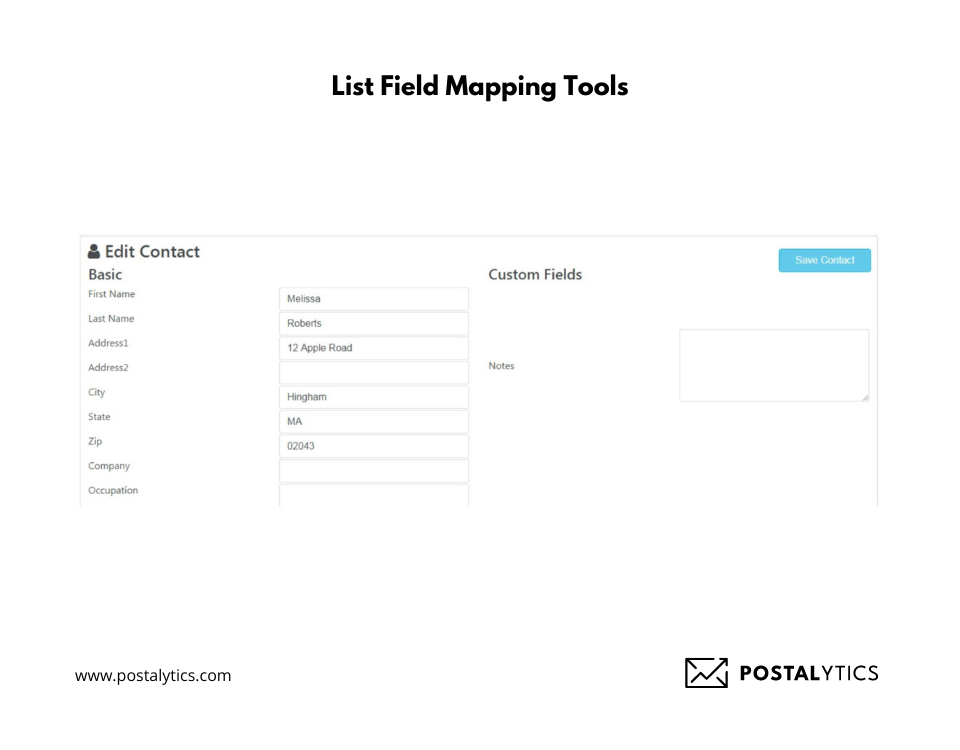
To map new fields, click the action button to the right of the list and select Field Mappings.

You can choose from existing standard fields or create a new one by entering the name in the Your Field Names Option.

Once you click Save, this field name will appear on your contact records.

Search/Delete Contacts (CCPA Compliance)
If you have created too many additional lists or you need to delete lists to maintain compliance, you can do so easily on the Postalytics platform.
Before you delete the list, ensure there are no active or scheduled campaigns using the contact records in that list.
To begin, go to the main navigation bar and click on Lists.
Find the list you want to delete and click on the action button right of the list. Click Delete to delete the list.
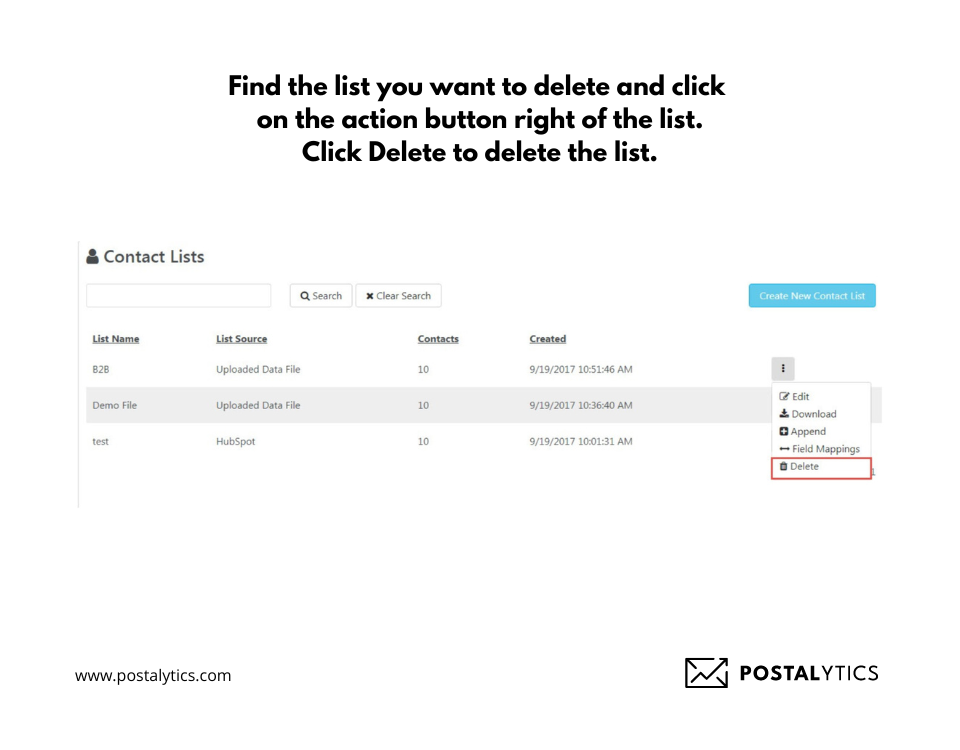
Any reports or campaign data associated with this list will also be deleted when this list is deleted.
How Direct Mail List Management Works
Direct mail list management can help you create effective and targeted campaigns within a matter of minutes. But how exactly can you manage different lists? Here are six tips that will help you.
Data Integration
You need a complete picture of your recipients to create better direct mail campaigns for them. This data should inform the right systems within your business and be detailed enough to give you complete information about your customers.
For example, if you know the actions your customer took on your website before signing up for an event, you can personalize your direct mail event invite accordingly.
To do so, your direct mail automation software should integrate with other marketing tools and provide metrics to measure the ROI of these campaigns.
Data Cleansing and Standardization
Keeping your direct mail list clean and standardized is of utmost importance. The four key benefits it brings are:
- Improves the effectiveness of your campaigns. The conversions you’ll get from a small but engaged list will be far greater than those from an extensive but disengaged list.
- Reduces your costs. Sending direct mails to an extensive list can burn money quickly. Your ROI will also drop because of that.
- Better customer relationships. You can do better personalization with a clean list and know your target audience.
- Better organization. When all your lists are in the same standardized format, it’s easy for your team to organize and search for things.
Segmentation and Personalization
Direct mail campaigns do best when there’s an element of segmentation and personalization in them.
After all, people are tired of receiving the same generic message that is sent to a hundred other people. If you want your recipients to act on your offers or CTAs, you must create targeted messaging that hits the mark.
The best way to do that is to segment your list based on demographic and behavioral data. For example, if you’re creating a mailing list for your newsletter, you can include those who regularly open and respond to your blog-related emails and have opted for your newsletter signup forms.
Suppression and Compliance
Regardless of your location, you must adhere to privacy laws and compliances. Many countries have laws regarding spam and consumer protection, so you don’t want to get your business unnecessarily involved in that.
One way to take care of this is by keeping your mailing lists clean and removing those recipients that have not engaged with your mailers multiple times.
You can suppress these contacts from future mailings or remove them completely from your lists. Instead of doing this process manually, you can use direct mail automation tools like Postalytics to delete or suppress contacts quickly.
Testing and Optimization
Before you deploy your direct mail campaigns, proof and test the design properly to ensure no inconsistencies while printing and that the right design reaches your recipients.
You can even use A/B testing if you’re confused with two designs or copies for your direct mail pieces. For example, you can compare subject lines, headers, main offers, colors and layouts, and other navigation elements while testing two styles.
Once that is done and your campaigns have successfully reached closure, check out the important performance metrics and analyze how you can optimize your future campaigns.
Maintenance and Updates
If your business runs many marketing campaigns, your team must continuously maintain and update these mailing lists. For example, you can keep adding new contact records for your newsletter emails as you keep getting more subscribers.
Similarly, once you send onboarding direct mails to your new customers, you’ll need to shift them to a different list so that you don’t send these mails again.
You can schedule these checks or create an automated workflow using direct mail automation tools like Zapier with your direct mail tools.
Final Thoughts
List management is the first step you need to take before you start your direct mail activities. Once you have your lists ready and organized, you can create better-targeted campaigns along with personalization elements that improve your conversions.
If you want to save time with your list management efforts, you can opt for direct mail list management software like Postalytics, which helps you create, manage and store these lists effectively.
You can even edit these lists or perform direct mail activities like creating campaigns, verifying addresses, personalizing campaigns with variable data and logic, etc.
Opt for the free trial of Postalytics to discover the different direct mail features on offer.
About the Author

Dennis Kelly
Dennis Kelly is CEO and co-founder of Postalytics. Dennis joined Boingnet, the predecessor to Postalytics, in 2013. Boingnet was focused on providing print and direct mail marketing service providers the ability to add digital marketing channels to their direct mail campaigns. Postalytics is Dennis’ 6th startup. He has been involved in starting and growing early-stage technology ventures for over 30 years and has held senior management roles at a diverse set of large technology firms including Computer Associates, Palm Inc. and Achieve Healthcare Information Systems.
